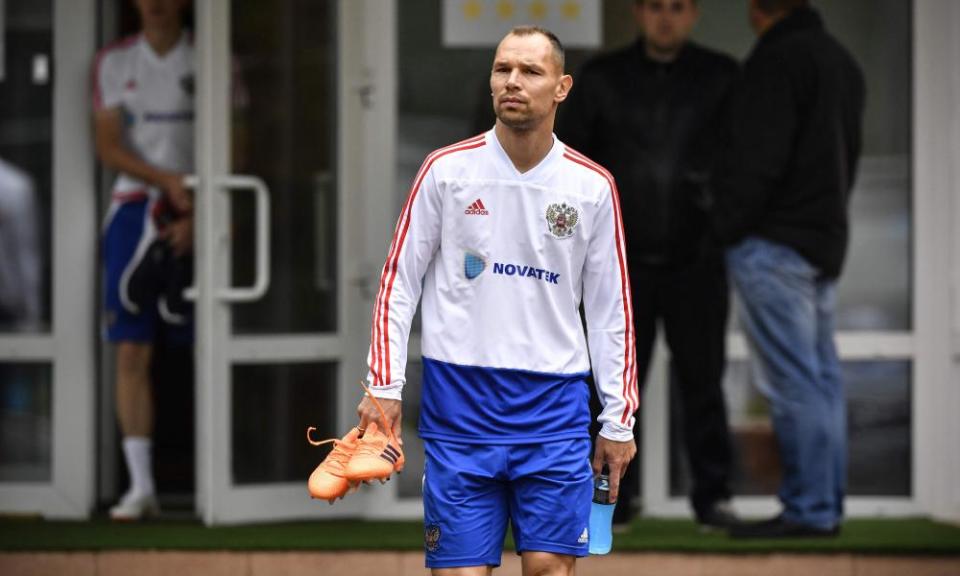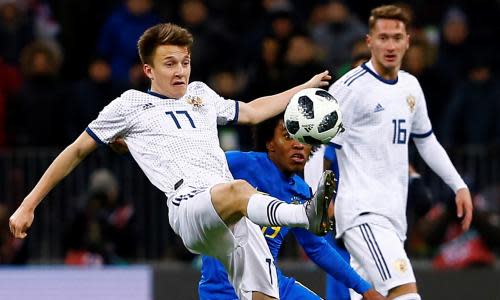Why are Russia so bad at football?
Aleksandr Golovin was born in the small Siberian town of Kaltan. Most of its 22,000 residents work in the mining industry, his first coach lost his hand in a mining accident and the only full-size football pitch is in a terrible condition even in the summer, not to mention the freezing winters.
Slightly built and a bit shy but determined and dedicated in the extreme, the midfielder was spotted by CSKA Moscow scouts at the age of 16. Nurtured carefully by the coach Leonid Slutsky, he was promoted to CSKA’s first-team squad in 2015, made exceptional progress and played for the national team at Euro 2016, albeit slightly out of position. By the time of the Confederations Cup in 2017, Golovin was absolutely integral to the side, frequently linked with a move to clubs such as Arsenal and Chelsea. In 2018 he is seen as Russia’s main source of creativity – at the age of 22.
READ MORE: Spain sack head coach Julen Lopetegui
READ MORE: USA, Canada and Mexico win bid to host 2026 World Cup
READ MORE: England hold first training session as Kane and Southgate are honoured
If only Russia could tell a few more stories like Golovin’s, they would have been a major force when staging the World Cup on home soil. In a vast country of nearly 145 million people, where football is the most popular sport despite fierce competition from ice hockey, there must be many similar talents waiting to be unearthed. But their chances of catching anyone’s attention are close to zero, while those who do miraculously make it into professional football do not receive the right help to develop.
The core of the problem is not financial. A lot of money has been poured into Russian football in recent times, especially since the country was awarded this World Cup in 2010, but it was not spent wisely. Instead of investing in academies, youth coaching and quality training pitches, including indoor facilities, it was wasted on expensive foreigners, agents’ fees and disproportionate salaries. As a result, few Russian players regularly performed at a decent level, while those who did largely lost all motivation to improve because they were spoiled.
It is quite curious to compare the current situation to that of the early 1990s, after the Soviet Union broke up. At the time Russian football was in a disastrous state economically and players dreamed of moving to western Europe. The most talented found themselves in the top leagues, such as Igor Shalimov and Igor Kolyvanov in Serie A, Andrei Kanchelskis in the Premier League, Valery Karpin, Aleksandr Mostovoi and Viktor Onopko in La Liga, and Sergei Kiryakov in the Bundesliga. Others went to earn their living in lesser leagues such as Israel. Their places in the Russian league were taken by up-and-coming youngsters and, while the level of football was not that great, they enjoyed a lot of opportunities to develop.
READ MORE: De Bruyne: Sterling will light the World Cup up
READ MORE: Rashford sits out England’s training session
Thus the generation of the 2000s grew up witnessing the international success of Russian players and wanted to follow in their footsteps. That is why players including Andrey Arshavin, Aleksandr Kerzhakov, Roman Pavlyuchenko and Pavel Pogrebnyak were desperate to prove their worth outside of Russia. In their era salaries at Zenit St Petersburg and Spartak Moscow were already quite high but that did not stop them. In fact they were ready to earn less in order to play at a better level. Times change, though, and the current generation is different.
With names such as Samuel Eto’o, Hulk and Axel Witsel lured to the Russian Premier League at the beginning of the decade, the salaries of homegrown players increased dramatically as well. In order to prevent clubs from fielding only foreigners, the Russian FA imposed a quota on non-Russian players allowed for each game. Consequently the price of the most talented Russians went up even further, the best example being the promising yet unproven striker Aleksandr Kokorin who earned €5m a year at Dynamo Moscow.

No club outside of Russia would have paid Kokorin even a third of that, thus there was no chance of him moving abroad. He did not feel the need to improve in the Russian league either, and seemed to concentrate on finding ways to waste his wealth. When reports of Kokorin and his team-mate Pavel Mamaev spending €250,000 on champagne in Monte Carlo after the national team were eliminated from Euro 2016 reached the home, fans easily believed them, even though the duo claimed the numbers were exaggerated.
Kokorin and Mamaev are not alone. Alan Dzagoev was considered one of the brightest teenage talents in the world a decade ago but the midfielder chose to stay at CSKA and his development had gradually stalled. Oleg Shatov, also born in 1990, showed remarkable potential in his youth but lost his way completely and was not considered for the World Cup squad. Both were 20 when Russia was awarded the tournament. Ideally they should be world-class stars by now, hoping to lead the national team to glory but, while they are far from blameless themselves, the system contributed to their downfall.
READ MORE: De Bruyne: Sterling will light the World Cup up
READ MORE: Rashford sits out England’s training session
A lack of planning is evident in every department of the national team. Take central defence. Everyone knew that Sergei Ignashevich would celebrate his 39th birthday during the World Cup, and the Berezutsky twins would turn 36. Nevertheless, even the limit on foreign players did not help. Apart from CSKA, all the top clubs still used foreign centre-backs and Russia were left without decent successors when the trio of veterans retired from the international game in 2016.
Stanislav Cherchesov, the Russia coach, was forced to use the inexperienced Georgi Dzhikiya, the unconvincing converted left-back Fyodor Kudryashov and the error-prone Viktor Vasin, who waited for his chance on the CSKA bench until the age of 28 – but even that emergency plan was ruined when Vasin and Dzhikiya tore knee ligaments earlier this year. Ignashevich has came out of retirement for the World Cup but the fact he is by far the best solution speaks volumes about Russia’s disastrous preparations.
The irony is there must be thousands of potentially top-class, physically strong centre-backs in Siberian towns such as Kaltan. The Russian game is just unable to find them, teach them, give them opportunities at the required level and send them out to get some experience in the top leagues. Thus those would-be footballers work in the mines instead, while Iceland – with a population of nearly 340,000 – is expected to have a much better World Cup.
The reason is obvious. Iceland were minnows until starting a magnificent long-term project at the beginning of the century, based on training youngsters, promoting youth coaches and building facilities that allow year-round playing. Russia invested their money in buying Hulk and building a white elephant of a stadium in Saransk instead. They are, quite simply, the exact opposite of Iceland, and that is their tragedy.

 Yahoo Sport
Yahoo Sport 






































